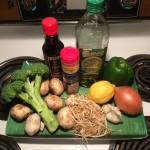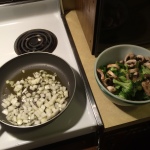This Meatless Monday, we feature a recipe for Stir-Fried Veggies and Bean Sprouts, as well as growing, storage and preparation tips for sprouts from our Vermont Fresh: A Fruit and Vegetable Handbook.
Jonathan Taft-Dick, a volunteer cooking, tasting and testing recipes out of the Vermont Fresh Handbook tested the recipes. His comments are below in italics.
Background
Humans have been eating sprouts for thousands of years. Sprouts are just the baby form of familiar plants such as broccoli, radishes, beans, and more. The seeds of these plants are saturated with water and allowed to germinate. After growing for a few days, however, they are eaten as little sprouts instead of maturing into full-sized plants. Although the history of sprouting is fuzzy, it is likely that the ancient Chinese were the first people to regularly include sprouts in their diet. Even today, sprouts (primarily bean sprouts) play a major role in Asian cuisine. It is rumored that, in the Age of Exploration, sailors ate sprouts to fend off scurvy while spending months at sea. Vitamin C-rich sprouts can be grown within a few days using no soil, a tremendous advantage aboard a ship. Sprouts have become popular in modern American cuisine only within the past few decades, in part due to food safety concerns associated with industrially-grown sprouts.
Growing Tips
Sprouts are exceptionally easy to grow, given that they require neither soil nor steady sunlight, can be grown any time of year, and will be ready to eat within days. “Sprouters” can be purchased from seed suppliers but a homemade setup will work just as well. Place a handful of sprouting-specific seed (as seeds are often treated when not for sprouting) into a mason jar and cover with water. Take a piece of old screen or mesh and affix to the lid of the jar with a rubber band. After seeds have soaked for several hours, drain excess water. Rinse and drain sprouts at least once a day until sprouts are ready. Different types of sprouts have slightly different requirements, so be sure to read any directional information accompanying your seeds.
Storage
It is best to eat sprouts as soon as they are ready, but you can store them in the refrigerator for several days. Dry sprouts thoroughly (a salad spinner works well) and seal them in a plastic bag before refrigerating. Sprouts that are stored wet have a tendency to rot.
Preparation
Sprouts are surprisingly versatile. They can be eaten raw in sandwiches or salads, added to stir-fries or sautés, or incorporated into sauces or spreads. To preserve to nutritional value of sprouts, do not overcook. Even the hardiest-looking sprouts generally need only about a minute of cooking. Bean sprouts are often blanched briefly and added to dishes at the last minute. Give sprouts a final rinse before cooking or eating.
Nutritional Benefits
Like many other fruits and vegetables, sprouts have periodically flirted with fame for being a “wonder food.” Although simply eating sprouts will not ensure good health, one can take in a variety of vitamins and minerals by munching on the little plants. Sprouts pack a surprising punch for their size and are loaded with Vitamin C, Vitamin A, and in the case of some varieties, protein and iron as well.
Meatless Monday Recipe: Stir-fried Veggies and Bean Sprouts
- Photo courtesy of Jonathan Taf-Dick
- Photo courtesy of Jonathan Taft-Dick
- Photo courtesy of Jonathan Taft-Dick
- Photo courtesy of Jonathan Taft-Dick
Serves 4
(adapted from www.cookingandme.com)
Ingredients
- 1 ½ tablespoons olive oil
- 1 medium onion, chopped
- 1 small head of broccoli, chopped (peel the stem and chop that, too)
- 1 cup mushrooms, thickly sliced
- 1 small green bell pepper, sliced
- 4 tablespoons soy sauce
- 2 teaspoons garlic, minced
- ¾ cup bean sprouts, either fresh or canned (rinsed and drained)
- ½ teaspoon chili powder
- 1 teaspoon powdered ginger
- 1 splash of lemon juice
Instructions
- Heat the oil in a skillet or wok over medium heat. Add onions and sauté until slightly translucent, about 5 minutes.
- Add the broccoli, mushrooms, bell pepper, and soy sauce. Stir-fry until vegetables are just tender, then add garlic and bean sprouts.
- Cook another minute or two longer, until garlic is golden and fragrant.
- Stir in chili powder, ginger, and lemon juice and remove from heat.
- Serve warm, over rice if desired. For variations on this recipe, try adding chicken, beef, or additional vegetables of your choosing!
Comments from Jonathan:
I love stir fries because they are easy, healthy, and delicious! The only problem with them is the amount of time you spend chopping all the ingredients, and this recipe isn’t any different. I spent about 20-30 minutes cleaning and chopping all of the ingredients (I’m not quick with chopping). However, once everything is prepped, the cooking process is very quick.
The onions took a few minutes, and then I sautéed everything else for about 10 minutes. I love garlic so I added a little bit more than the recipe called for. My only substitution on this recipe would be to use real ginger instead of ginger powder. I really couldn’t taste ANY ginger in the finished product. I would probably shave about 2 teaspoons of real ginger and put it in about the same time you add the garlic, that way you get some real ginger flavor.
Before I started chopping I started to cook a cup of brown rice to go along with this recipe. I would recommend either adding more ingredients to this recipe, or serving it with rice, so that it can adequately serve 4 people. Just on its own it would serve only two people. It was just my father and I and with the rice, there was enough for each of us to have a leftover dish the next day.
All in all the recipe was great, for great flavor use a good quality soy sauce. The texture was great – nice and crunchy with the sprouts and veggies complemented by the nice soft brown rice. I purchased all the ingredients at my local COOP so they tended to be organic/local and were a little pricier than the local supermarket.
- Broccoli: $2.60
- Onion: $1.00
- Green pepper: $1.20
- Sprouts: $2.95
- Lemon: $1.60
- Mushrooms: $1.70
- Garlic: $1.00.
I already had a bottle of olive oil ($6-$20), chili powder ($2-$5), and ginger powder ($3-$8). So I paid about $12 for the ingredients I didn’t have. Add another $10-$20 for all the ingredients I already had.
To receive more recipes and tips on your favorite fruits and vegetables, download Vermont Fresh: A Fruit and Vegetable Handbook. We also need more volunteer home chefs for this project.
Vermont Foodbank fresh food initiatives would not be possible without your support. Please consider giving to the Vermont Foodbank today!





